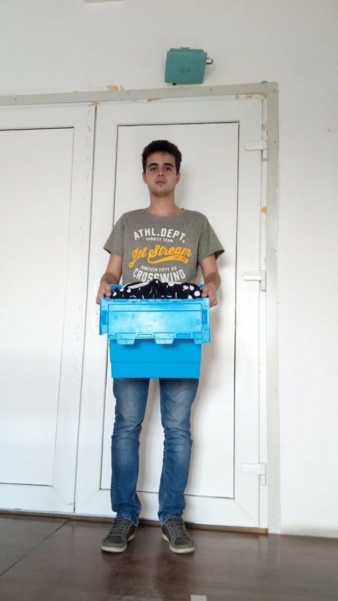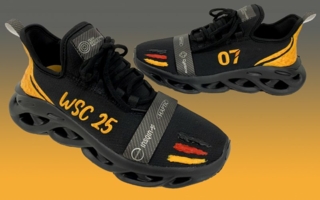13/02/2020 – RFID technology — auf Deutsch lesen
Cottontex SRL implemented a digital solution by Dresden Informatik GmbH
Efficient tracking and tracing in production and intralogistics is still one of the essential factors of success, also in the textile industry.
Where are the orders? Where is the material? How long will it take? Who has the pattern?
These are typical questions we often hear in producing companies. The solution is the implementation of efficient and universal tracking and tracing systems.
In this case, an asset tracking of textile fabrics and sample garments was required at Cottontex SRL. The solution is based on a modular software for tracking and tracing by Dresden Informatik GmbH which is already used by more than 500 companies worldwide. In this project, the objects to be tracked were identified by RFID technology.
The challenge
The enterprise Cottontex SRL from Timisoara with various plants in Romania was facing the challenge of tracking model garments and a sample each per batch on the enterprise’s premises in order to find them quickly if required.
Model fabrics are prototypes which are required in production, industrial engineering, and distribution likewise. In the past, these garments often couldn’t be found immediately. The time wasted for search significantly inhibited production processes.
The challenge was therefore to implement a solution allowing to determine or at least narrow down the location of those garments in the plant quickly in order to perform a fast and pointed search and find process.
It had to be taken into consideration that the complete plant consisted of several halls and other buildings, and that further plants would be added in future.
The fabrics and garments to be tracked were transported in plastic containers containing up to 30 such items in coincidental order.
Another requirement was that these items had to be tracked automatically by the company during transportation without any human action such as manual scanning or listing.
The solution
It quickly became clear that only the passive RFID technology in the frequency of 868 MHz was fit for labelling and identification of model fabrics.
Initially, a laboratory test was performed at Dresden Informatik GmbH in cooperation with the management of Cottontex SRL and the company PRISM S.R.L. from South Tirol, followed by a proof of concept on site in Timisoara (Romania).
The result was that the readers and antennas from Siemens, type Dogbone UHF-Labeltransponder, as well as one MDE (mobile data acquisition device) by Nordic ID were chosen.
The RFID antennas were installed at 31 checkpoints in total, such as doors and gates. Per checkpoint there is (at least) one antenna. As the RFID readers have up to four antenna connections, the antennas of several checkpoints could be connected to one single reader. The devices were installed and connected by Cottontex SRL. Commissioning was the responsibility of Dresden Informatik. Middleware designed by Dresden Informatik GmbH ensured the integration of the RFID technology into the soft- and hardware environment.
A monitoring system in the tracking software supervises the correct performance of the readers. If the system identifies any faults such as a breakdown of network connectivity, it triggers an email to the responsible persons. Additionally, this information is displayed on the tracking software’s dashboard.
When listing a model garment, a six-digit progressive number (sample ID) is automatically generated by the tracking software, which also adds further individual data (such as customers or layouts) which is available for assessment e.g. as selection criteria.
The sample ID
The sample ID is stored in „our memory“ of the respective transponder by an RFID table reader. Then the transponders are fixed to the model garments. When passing a checkpoint, the sample IDs are automatically identified in a pile and transferred to the tracking software.
When tracking an item, the tracking software initially searches for the respective sample ID to identify the last point of registration. This reduces the research area significantly.
If the respective transponder is still in the scanning area of an RFID antenna at the time of research, this is also visualized by the asset tracking software, thus further reducing the research area.
The final search process on site is also supported by a mobile RFID device (MDE). To this end, the sample ID is initially typed into the device via the MDE keyboard. If the transponder with the respective sample ID is identified by the MDE, this is indicated by optical and acoustic signals depending on the distance to the MDE.
When the precise storage place is identified, this can be added manually to the tracking software’s data as additional information.
In case items are conveyed on routes without installed RFID antennas, they can be identified by MDEs.
Moreover, MDEs are also used for inventories.
Assessment and results
Apart from the research functions, the tracking software includes comprehensive tools for data assessment – including for example the history of each sample ID (date, time, and place of each identification).
Any results can be exported into Excel files and are available to users for their own assessments.
The implementation of a tracking system drastically reduced the search time for model garments and lot samples. Existing software solutions were replaced and simulated in the tracking software.
The process transparency was increased as a precondition for further process improvements. The modular structure of the tracking software allowed to efficiently match it to the requirements of Cottontex SRL. Because of the very positive results, the project has meanwhile been extended to a further plant.
Andreas Widmann, Texmarket SRL, and Thomas Menzel, Dresden Informatik GmbH



